The best-known boats of the Adirondack region of northern New York are, of course, the Adirondack guideboats—sleek, lightly built double-enders with tumblehome stems. Designed to reach some of the smaller, less accessible lakes, they were developed to be carried as much as they were to be rowed.
Not everyone drawn to the Adirondacks needed a boat that was easily portaged. Lake George, second only in size to Lake Champlain, is 32 miles long and up to 3 miles wide. Set apart from the network of lakes that gave rise to the guideboat, it produced another type of boat, called, naturally, a Lake George boat. This is a lapstrake pulling boat, very much like a Whitehall, but lacks the wineglass transom. Light construction and a trace of tumblehome in the stem hint at the influence of the Adirondack guideboat. WINONA, a Lake George boat built around 1911 by Jared Bartlett of Sabbath Bay Point on the western shore of the lake, is now in the Mystic Seaport collection. Her lines were taken off in 1983.
Tom Regan of Grapeview Point Boat Works wanted to build a fast rowing boat and took an interest in WINONA; he decided to make a version of the boat for his home waters on the tidal fringes of Washington’s Puget Sound. He began the process by making a 1:8-scale half model to get the shape of the boat he wanted. He would narrow the beam from 50″ to 45″, diminish the width of the transom, and forgo the tumblehome stem for one with a bit of rake to keep the boat a bit drier in a chop.
 Photographs by the author
Photographs by the authorThe Ebb first took shape as a half model. Wires were bent around it to transfer the sections to drawings for further development.
In 2015, Tom built the first, and as yet only, Ebb for his own use. Like WINONA, it is lightly built and weighed just 85 lbs before the paint went on. The paints and hardware contribute about 15 lbs to the finished boat. WINONA was planked with 1/4″ white cedar and framed with 3/8″ x 5/8″ oak on 5″ centers. The Ebb’s planks are 4mm okoume marine plywood from Joubert, and the steam-bent frames are 5/16″ x 5/8″ Alaska yellow cedar on 6″ centers.
No hardwoods were used in the Ebb: Alaska yellow cedar served for everything but the thwarts and floorboards, which are of Western red cedar. The departures from WINONA’s composition helped Tom meet his target for the Ebb’s weight—light enough to load singlehanded on his truck’s rack. A replica of WINONA built under Regan’s guidance at the Gig Harbor BoatShop, a nonprofit dedicated to preserving working-waterfront traditions, incorporated hardwoods that WINONA had, and finished up at 165 lbs.
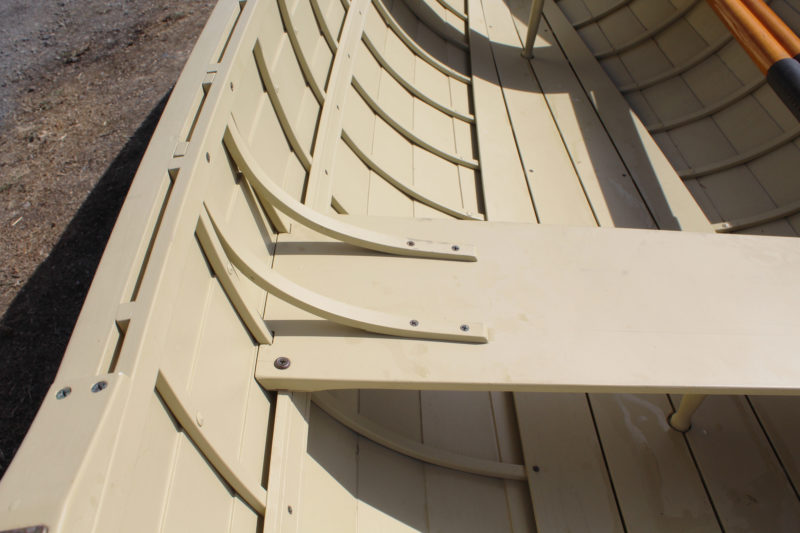
The steam-bent knees are light in weight and adequate for a boat that is meant for rowing and not subject to the racking forces of sailing.
I’m used to seeing a lot of fastenings punctuating the frames and laps—which tears up both sandpaper and knuckles during finishing and refinishing—but there are just a few rows of roves visible on the frames at the sheerstrake and just above the floorboards. Ebb’s construction is glued-lap plywood with steam-bent frames, and rivets were used only where required to hold the hull’s shape. The smooth surfaces will make refinishing a much more pleasant task.
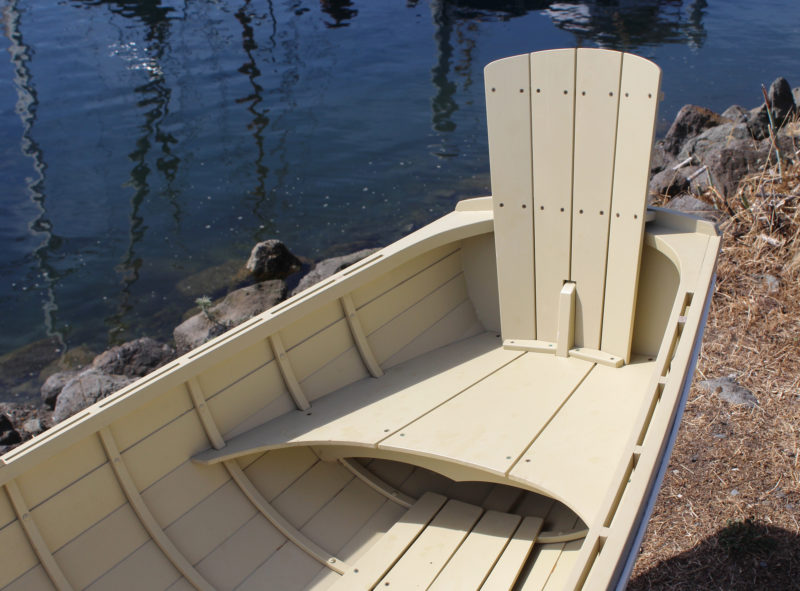
The tall back rest slips in place and has a cleat that bears on the inner face of the transom.
I rowed the Ebb on two separate occasions. The first was at Port Townsend and required carrying the boat across a rough shore with large rocks to avoid and orange-sized rocks that made for unsteady footing. Tom and I were able to carry the Ebb to the water to launch it but we had a third person help carry the boat back ashore when I returned and it was much easier. The second outing was on the little inlet by Tom’s boatshop. The two of us could easily lift the boat onto a dolly; it’s wheelable solo, so one could do a dolly launch singlehanded.
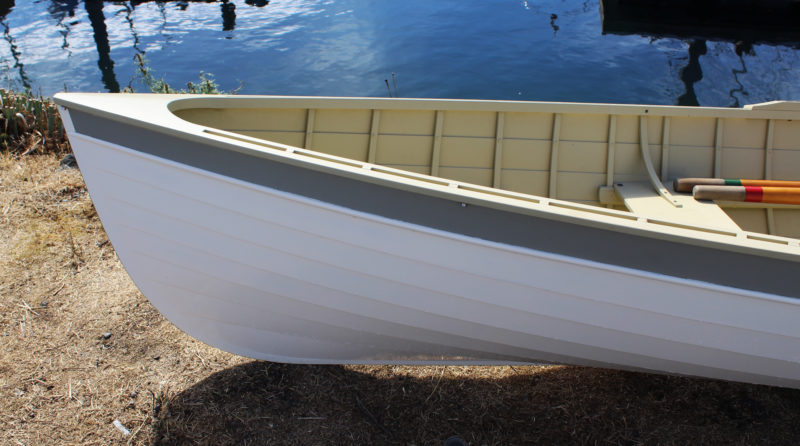
While WINONA had a touch of tumblehome in its stem, a common feature of Adirondack guideboats, Ebb’s stem is angled forward.
The soft bilges made the Ebb feel just a little bit wobbly when I stepped aboard, but the boat steadied itself when I got myself seated. I could lean over the gunwale and look straight down past it to the water without any fretting that the boat was going to roll out from under me. With a passenger in the stern setting the hull deeper in the water, the Ebb was quite steady.
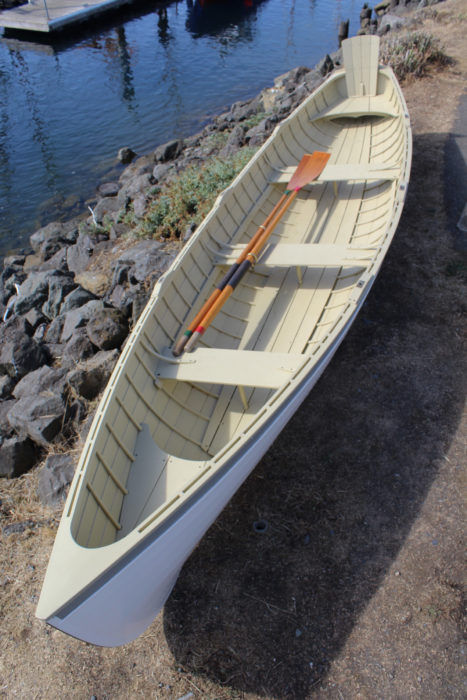
The Ebb has three rowing stations. The placement of the forward and aft stations favors generous spacing between rowers rather than keeping the ends light.
WINONA had two thwarts and seating in the bow and stern. With two rowing stations, she could be rowed solo from the amidships thwart, or rowed from the forward thwart with a passenger in the stern. Tom added a third thwart; the Ebb can be rowed solo from the middle thwart and tandem from the other two thwarts. The thwarts are 32″ apart, plenty of room to allow a pair of rowers, one on the aft thwart and the other on the forward thwart, to get out of synch without clashing oar blades. Tom suggests three kids might enjoy rowing the Ebb as a triple without overburdening it. The spacing of the thwarts also provided excellent foot bracing (at least for me, at 6′ tall, with size-13 feet) at the middle and forward stations.
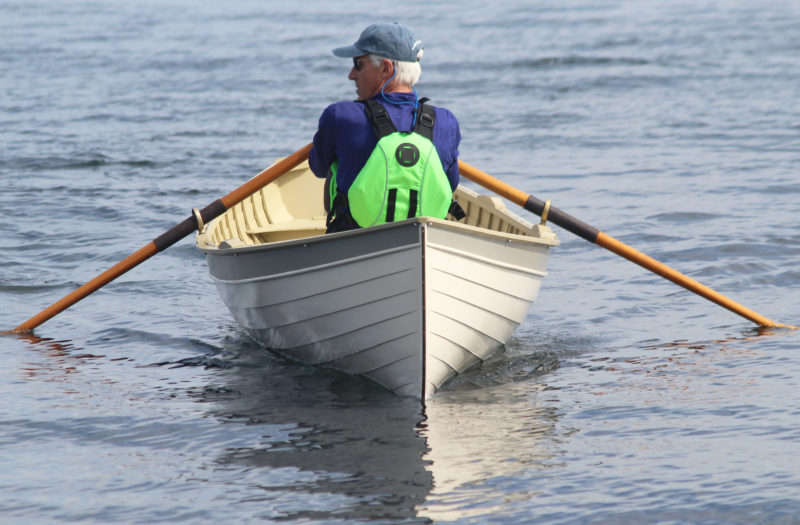
The Ebb’s planks are evenly and beautifully lined off. The sheer strake caries its guards and the outwales without looking pinched at the stem.
A pull or two on the oars, and the Ebb was quickly moving at a good clip. The long, ample skeg kept the boat from wandering so I didn’t have to keep watch over the stern to keep my course. There was a light breeze, about 8 knots, and it had no detectable effect on the Ebb’s ability to stay on track across the wind, even when I let the boat coast. The Ebb, consequently, isn’t a quick turner. It took 14 strokes, pulling one oar, backing the other, to do a 360, a few more than other pulling boats.
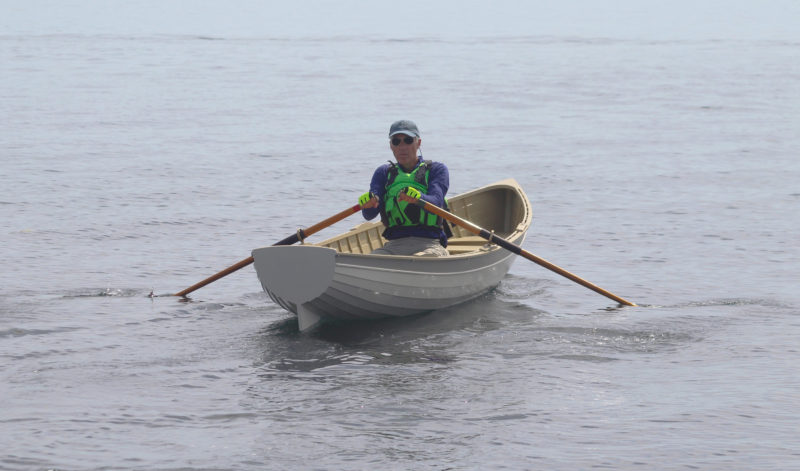
An ample skeg keeps the Ebb in line.
While the Ebb is easily moved under oars, its light weight made measuring its speed difficult. Weighing well under half my weight, the Ebb followed Newton’s Third Law of Motion with élan. It had an equal and opposite reaction to the swing of my torso back and forth, speeding up as I swung aft during the recovery and slowing down as I heaved toward the bow during the drive. You might not feel the effect while rowing unless you paid close attention to the water curdling astern, but a GPS certainly notices it. The numbers to the right of the decimal point never settled down.
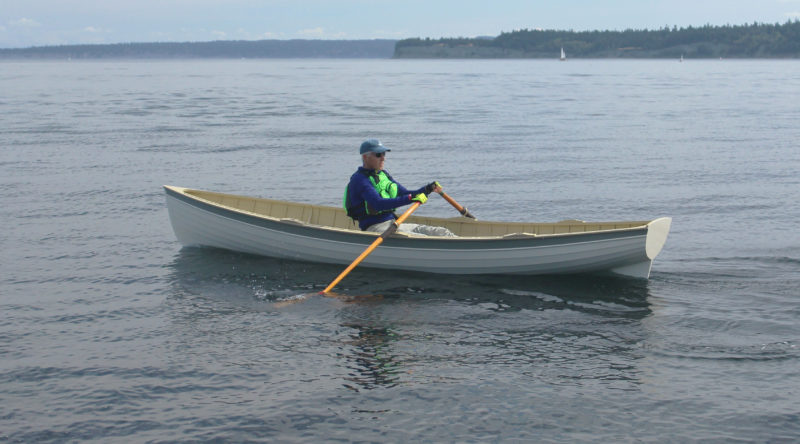
It takes very little effort to get keep Ebb moving in excess of 4 knots.
Rowing solo and averaging the speeds of several runs in opposite directions in a current-free cove, I easily made 4-1/2 knots with lazy pace. I could back the Ebb at 3-1/2 knots, not bad considering I didn’t have my feet locked down. Ramping up to a sustainable aerobic effort rowing forward, I held 4-3/4 knots; in short sprints I made an average top speed of 5 knots. Tom hopped aboard and sat in the stern; I shifted to the forward rowing station. He could make a better reading of the GPS than I could rowing solo, and surprisingly he came up with an averaged top speed of 5 knots.
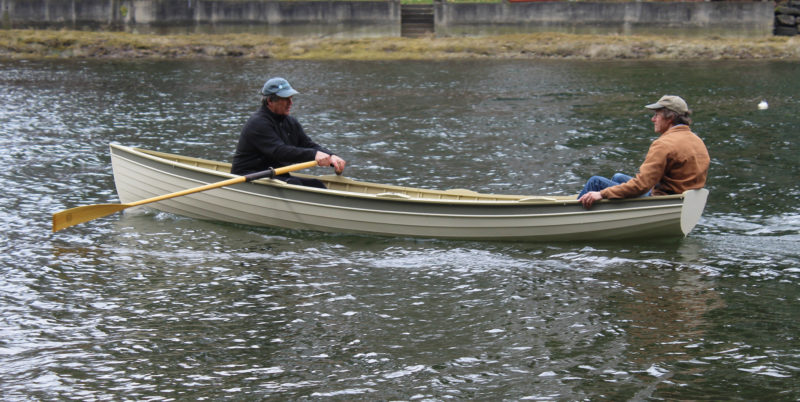 Susanne Regan
Susanne ReganWith two aboard, the Ebb maintains its proper trim and keeps its transom above the waterline.
To see how fast the Ebb should be by the numbers, I started by taking measurements on Tom’s drawing. The waterline length from cutwater to the trailing edge of the skeg was 15′ at a 7″ draft. The theoretical hull speed (√WL x 1.34) based on that length is just under 5.2 knots, a bit more than my sea trials demonstrated. But that waterline length includes 11″ of skeg, which is just an appendage and doesn’t contribute to the length of the hull form. Taking the measurement to the rabbet gave a waterline length of 14′1″ and a theoretical hull speed just a tick over 5 knots. That was a good match for my speed trials.
There wasn’t anything unusual about pushing the Ebb up to its top speed; what I found interesting was the 1/2-knot difference between speed at a relaxed pace and the speed at full effort. I’m used to seeing a span about three times that. In another lightweight pulling boat I rowed recently, the Drake Race Boat, the speeds I recorded were, respectively, 3-3/4, 5, and 6 knots. As the name of that boat suggests, the top speeds were the ones that mattered to the designer. The bottom number is more pertinent to a wider range of rowers. I suspect Tom minimized the surface area of the hull to give it better speed at the low end. If you’re out for a relaxing day’s row, wouldn’t it be appropriate to have a hull that is efficient at slow speeds and gives you the best return on your investment of effort?
Tom would make a few tweaks to the Ebb for any subsequent builds. A smaller skeg, for instance, would improve maneuverability without giving up much tracking ability. The only change I’d request would be to make the floorboards a bit sturdier—I weigh enough more than Tom to put him on the high side of a playground teeter-totter, so I’d hate to come down hard with a heel on a floorboard between frames and spoil a day’s outing. Everything else suited me just fine. The Ebb was a treat for the eyes and a pleasure to row, meeting Tom‘s goal to design “a fast pulling boat with a traditional appearance, but built as lightly as reasonable without sacrificing aesthetics.”![]()
Christopher Cunningham is the editor of Small Boats Monthly.
Ebb Particulars
[table]
Length/15′9″
Beam/45″
Draft/7″
Weight/approx.100 lbs
Capacity/3 adults
[/table]

Update, November 2022: The Ebb is no longer available as a finished boat from Grapeview Point Boat Works. No plans are available.
Is there a boat you’d like to know more about? Have you built one that you think other Small Boats Monthly readers would enjoy? Please email us!
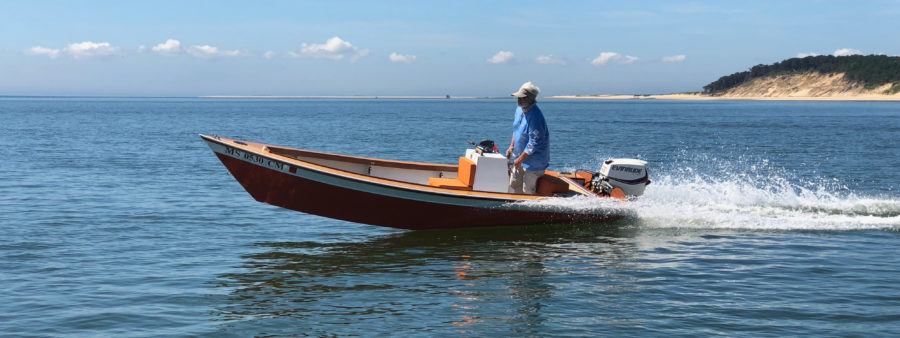
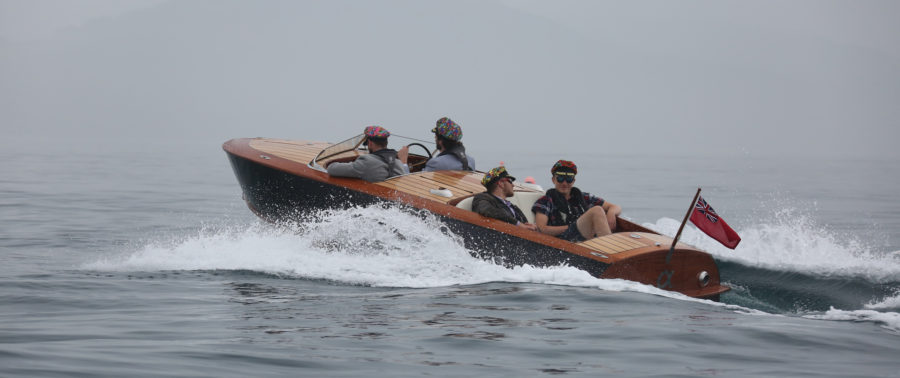
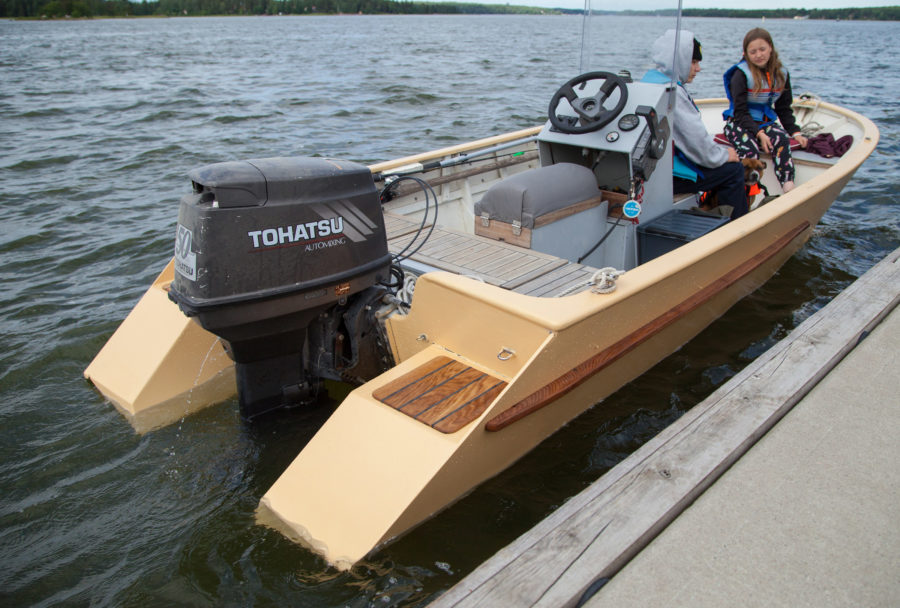
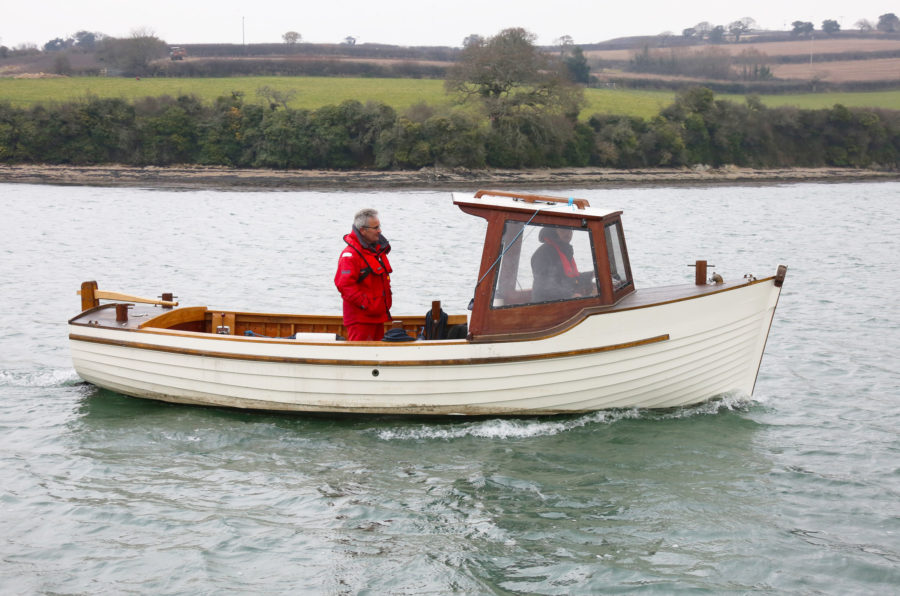
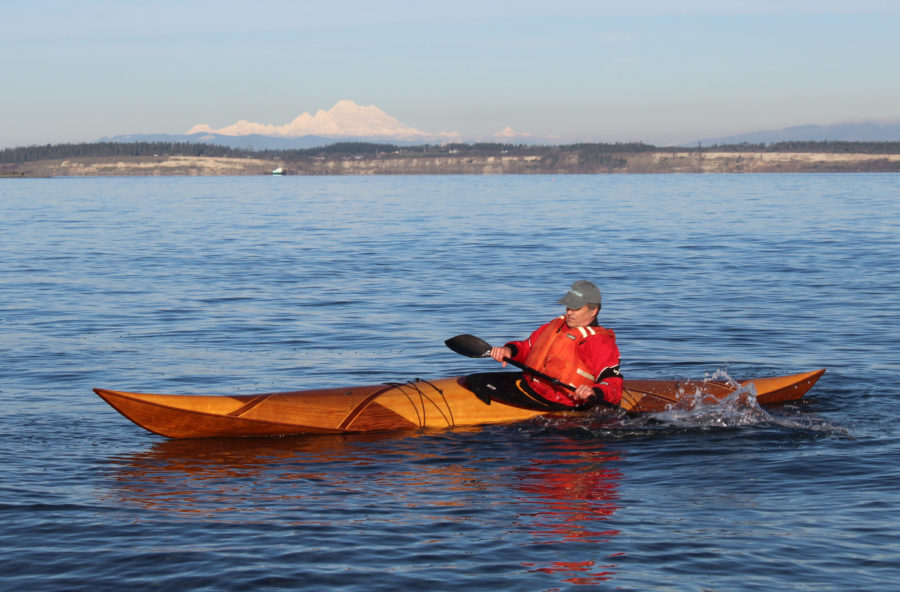
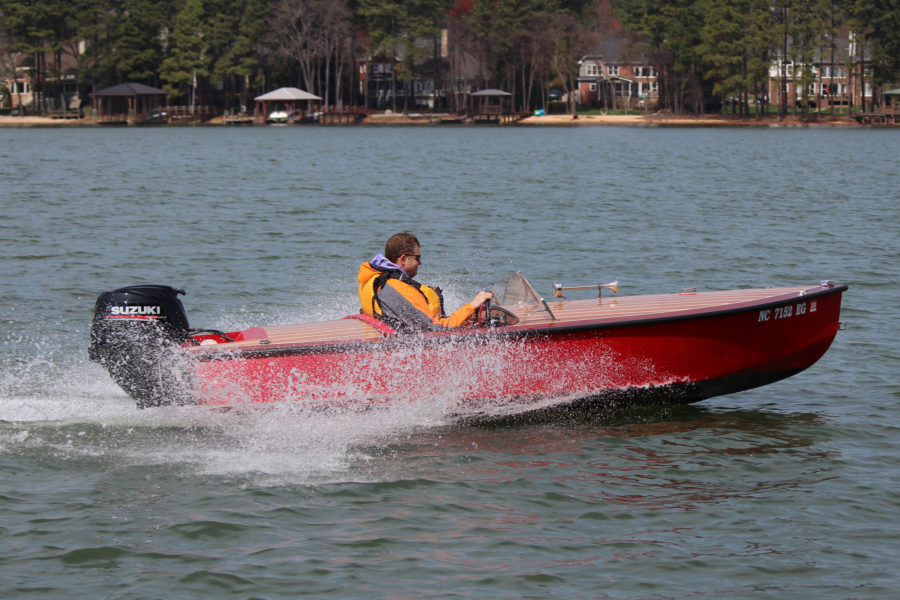
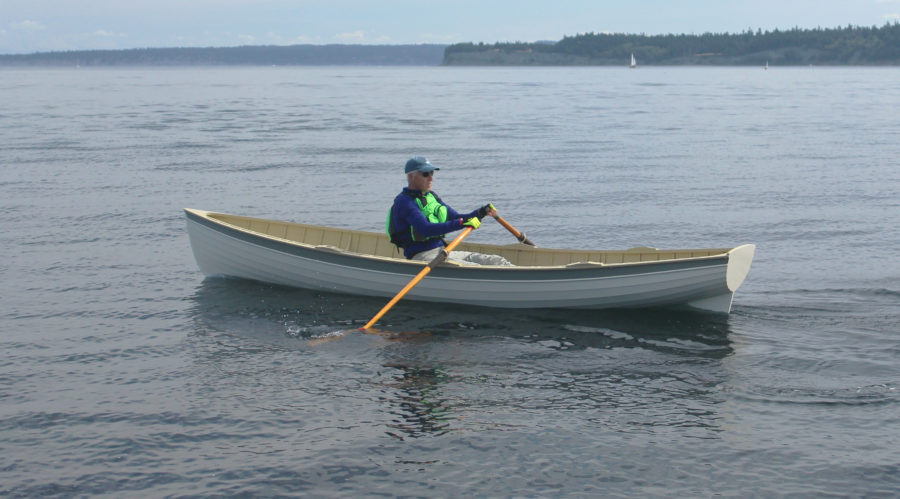
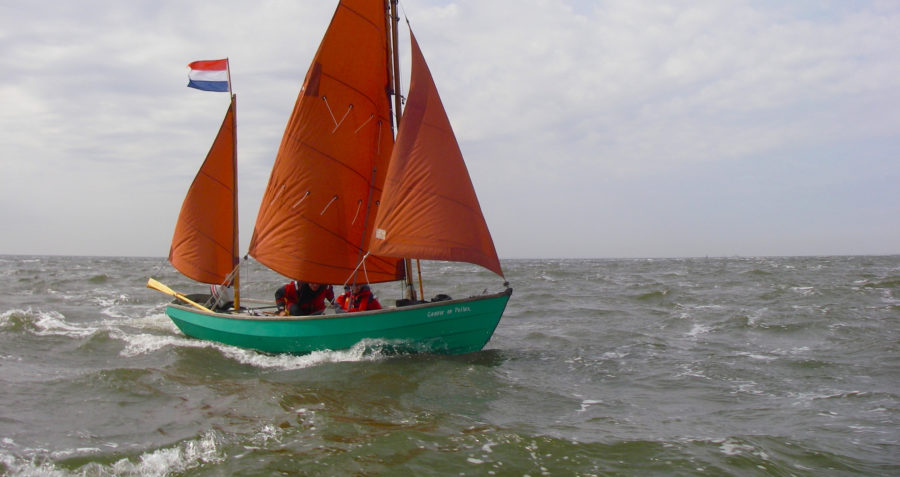
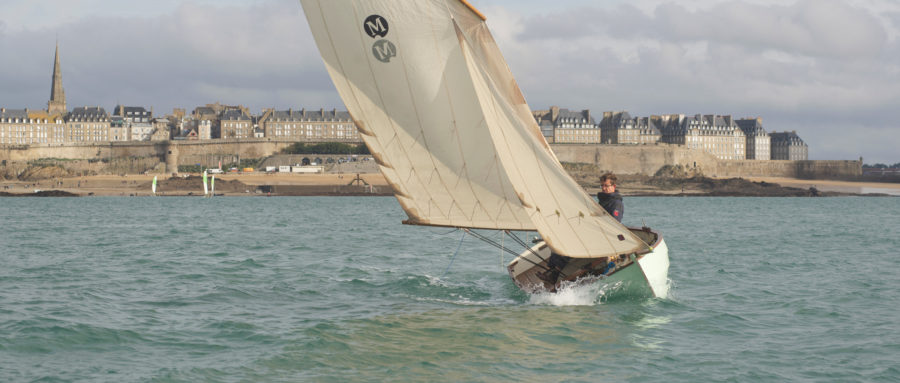
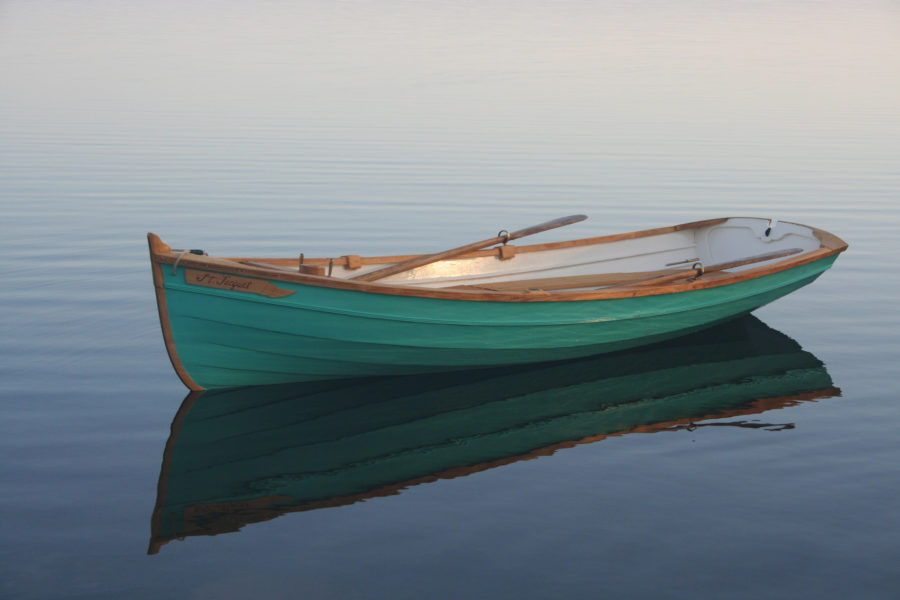
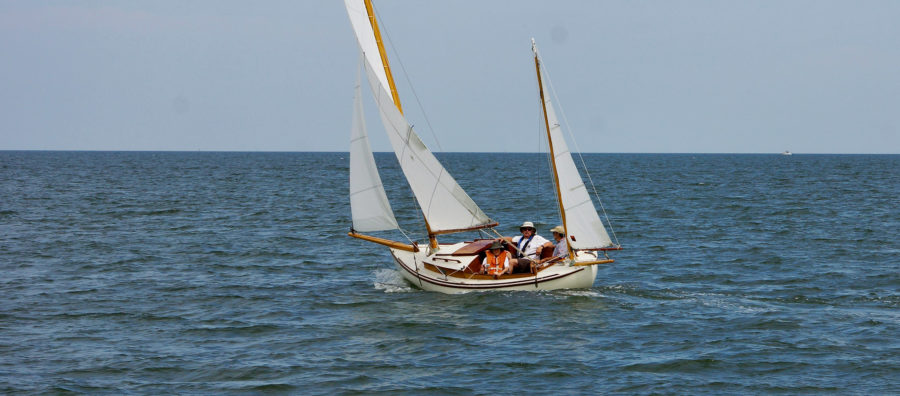
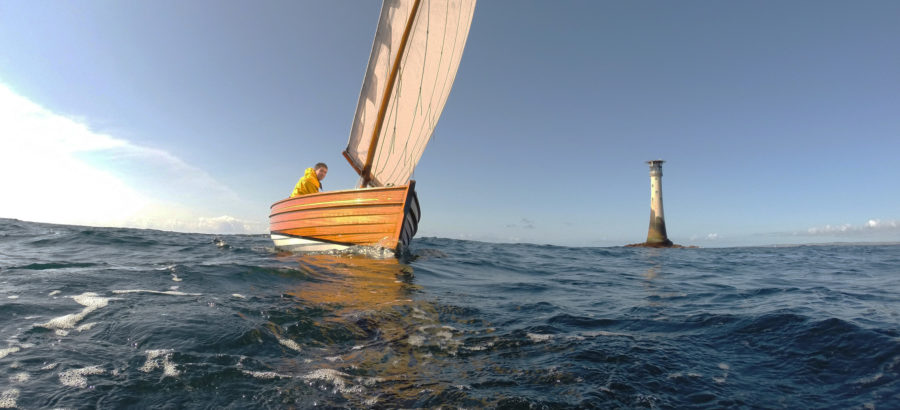
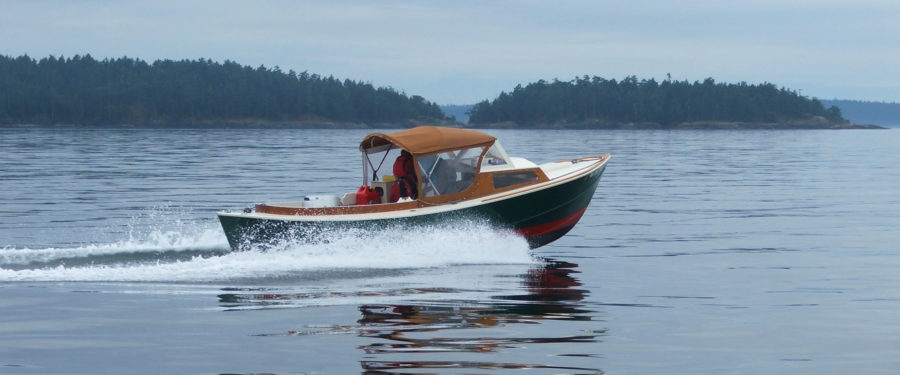

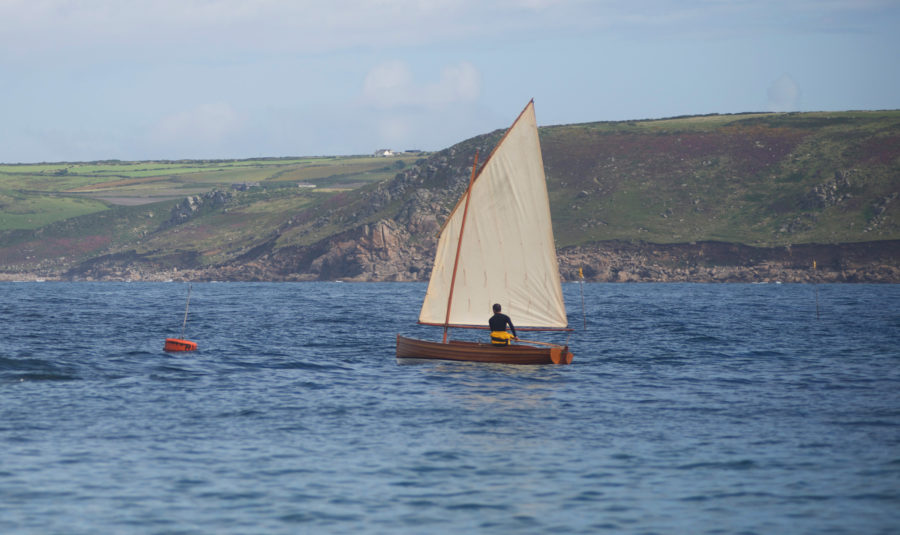
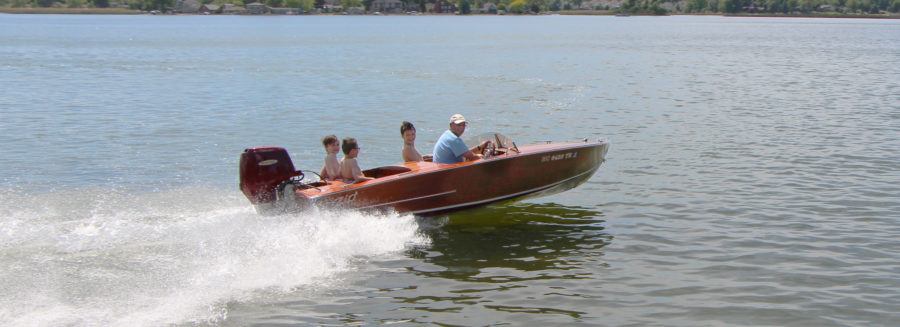
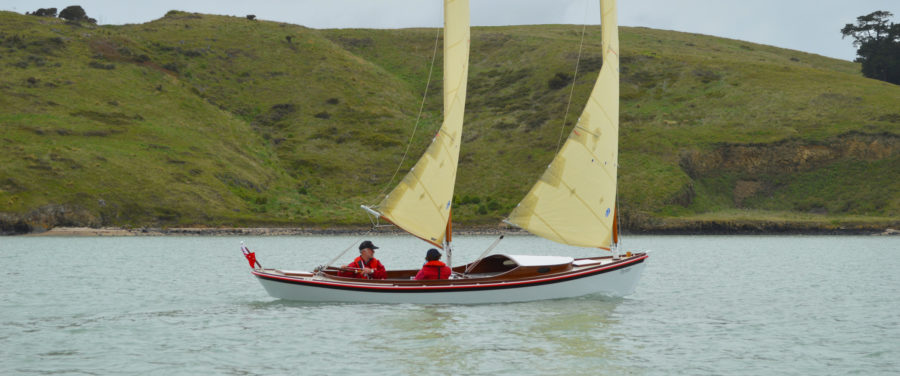
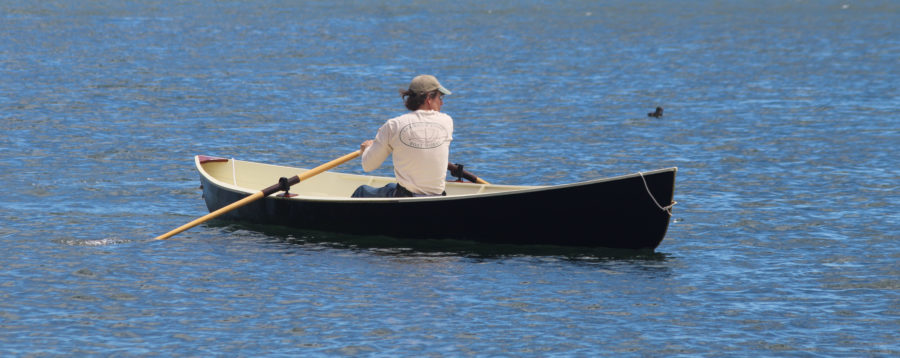
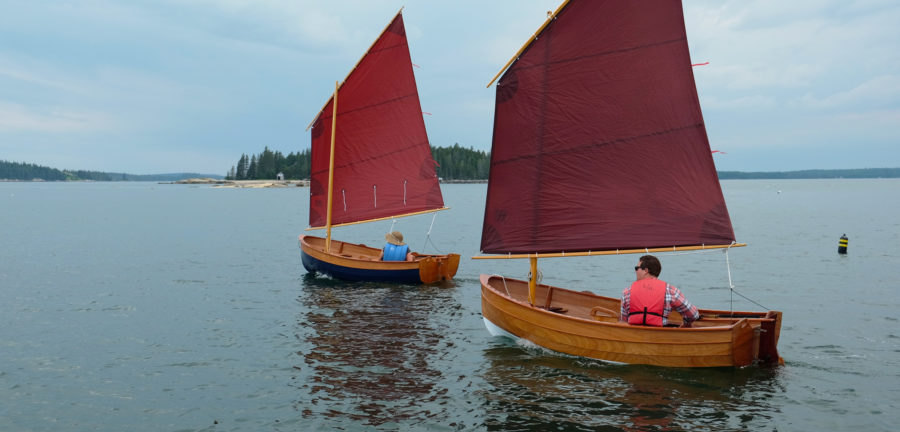
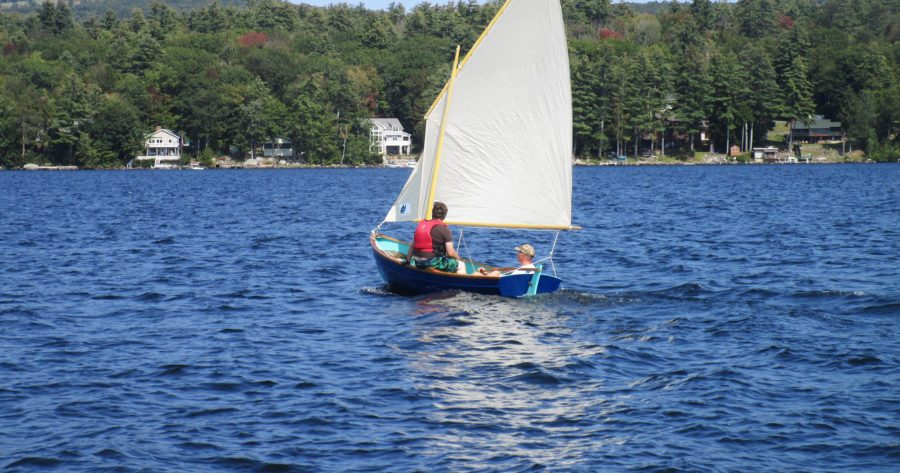

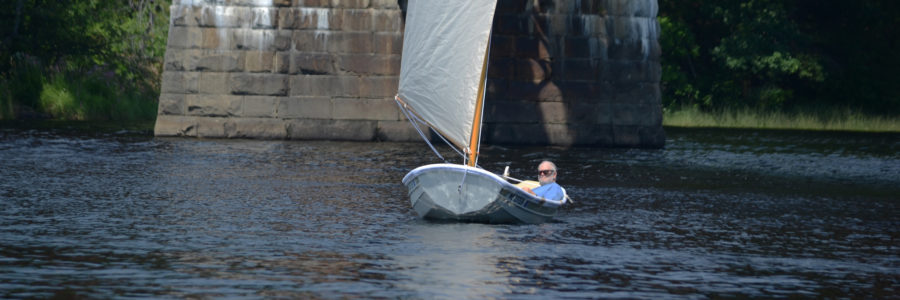
Excellent description of a well-chosen and well-executed recreational rowing boat. I applaud Tom’s judgement in designing for a fast “top end” when desired but emphasizing a more relaxed effort and pleasant on-the-water experience lower on the speed scale.
I rowed the boat at Port Townsend as well and although I didn’t have a GPS in the boat, I was also struck by the lack of momentum to carry you between strokes. But, as Chris has noted and measured, the high average cruising speed means that this is relatively unimportant most of the time. The question for me would how would the light weight affect the boat if you were rowing into a chop. The boat certainly is fun to just get out and row and enjoy the water and the experience.
Didn’t get chance to row her at Port Townsend. I know the original and noted the change in the stern right away. Couple of things that it does for you: it makes a neater job of a backrest, you can go to a double-ended boat style, and by tucking it in, it comes under the CG regs for a canoe-style boat, not an outboard. The boat had some of the best detailing I’ve seen, like the oarlock pads. With two aboard, you were down closer to her waterline length. The original was part of a livery as I recall and hence rarely rowed single. As far as weight and a chop go, the biggest thing that seems to affect rowing boats in wind is windage. My ducker, somewhat lighter than the dory, sneaks under wind that pushes the dory around.